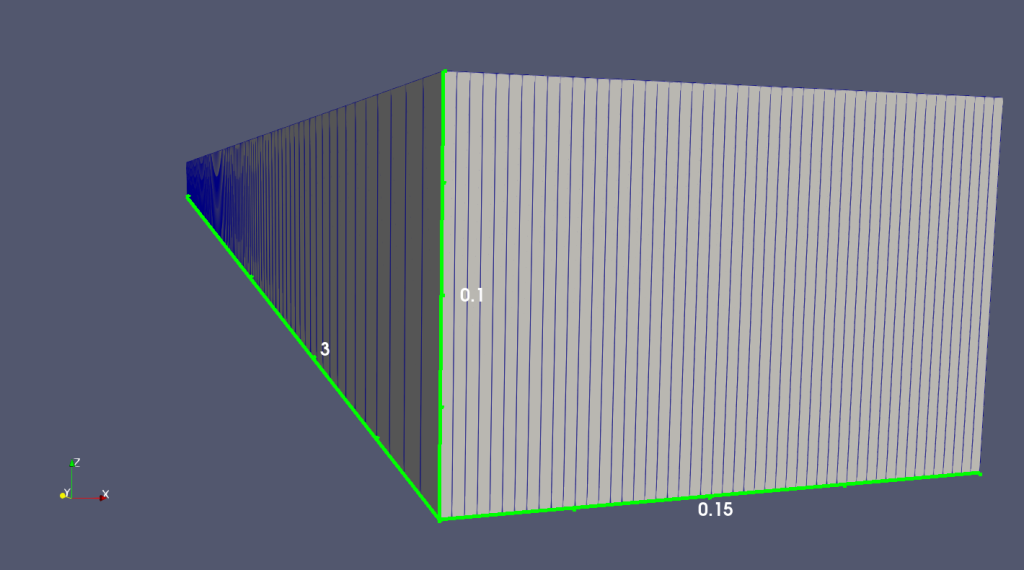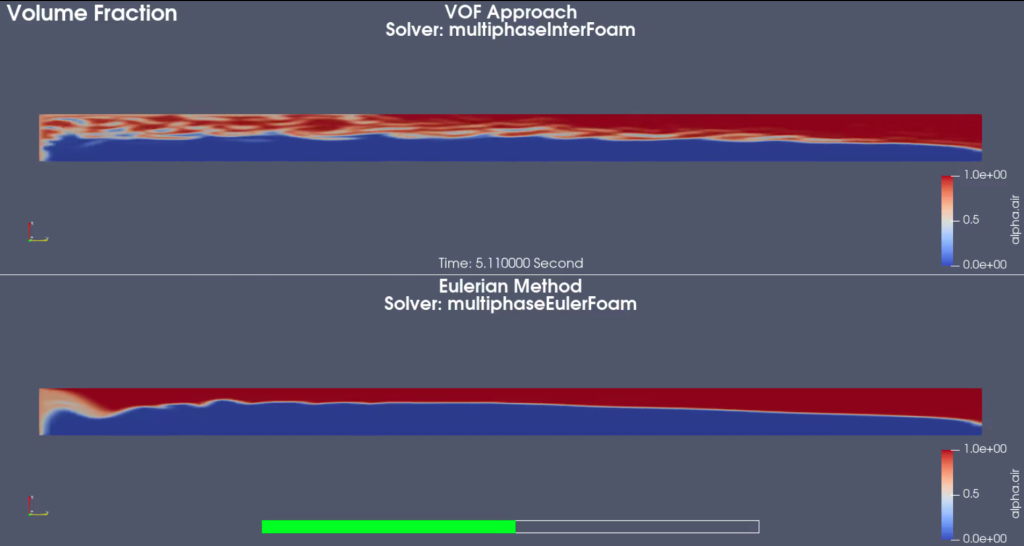Introduction
Two-phase flow simulations are fundamental in understanding and analyzing the complexities of systems where two distinct fluids, like air and water, come into interaction. These simulations study the intricate dynamics, behaviors, and interactions of these fluids when they coexist and move within the same domain.
Across various industries, the insights from two-phase simulations are invaluable. In the oil and gas sector, they play a central role in understanding oil recovery and pipeline transport. In the realm of renewable energy, especially in hydropower and wave energy, the simulations provide crucial knowledge about flow behaviors that directly impact design and efficiency. Furthermore, these simulations are also vital in the food and beverage industry, wastewater management, and even in some medical applications, such as drug delivery systems.
Within the broad spectrum of computational fluid dynamics (CFD) tools available, multiphaseInterFoam and multiphaseEulerFoam stand out as two of the most used and versatile solvers tailored for multi-fluid challenges. While they both aim to address the challenges of multi-fluid dynamics, their core methodologies, philosophies, and ideal application scenarios can vary. In this post, I will introduce these two solvers, shed light on their key features, and delve deeper into their comparative strengths and limitations.
Fundamental Differences
Understanding the distinct approaches of multiphaseInterFoam and multiphaseEulerFoam is key to selecting the most appropriate tool for a given two-phase flow simulation. Here, I delve into the fundamental differences between these two prominent solvers:
multiphaseInterFoam:
At its core, multiphaseInterFoam uses the Volume of Fluid (VOF) method. This method is characterized by tracking the interface between different fluids by introducing a scalar field that represents the volume fraction of one of the fluids in the domain. By doing so, it ensures a sharp capture of the fluid interface without any mixing or smearing. Due to its ability to maintain a clear distinction between fluids, multiphaseInterFoam is particularly suitable for free surface flows where capturing the interface accurately is of utmost importance. Examples include waves breaking on a beach, the spill of a liquid from a container, or the rise of an air bubble in water.
multiphaseEulerFoam:
Unlike the VOF approach of multiphaseInterFoam, multiphaseEulerFoam adopts an Eulerian-Eulerian framework. In this approach, each phase is considered a continuum, and its own set of momentum, continuity, and energy equations are solved. The interactions between phases, including drag and turbulence effects, are accounted for using various interphase force models. multiphaseEulerFoam is tailored for dispersed phase simulations where the distinction between phases is not as sharp, or where complex interactions occur between the dispersed and continuous phases. This makes it apt for scenarios like sediment transport, fluidized beds, or spray simulations where multiple droplets or particles coexist within a primary fluid medium.
In summary, while both solvers are adept at handling multi-fluid challenges, their inherent methodologies direct them towards different application areas, making each one shine under specific conditions.
Simulation Setup
The simulation revolves around a rectangular pipe geometry. By examining the provided blockMeshDict file, we gather that the pipe’s dimensions, given in meters, are 0.15 meters in width, 3 meters in height, and a depth of 0.1 meters. This orientation suggests the flow’s primary direction is along the pipe’s height, while its width and depth define the cross-sectional area through which the flow occurs.
Moving on to the mesh details, the pipe’s computational domain consists of hexahedral cells, as determined by the block defined using all eight vertices. The grid resolution for this domain is specifically set to 50 cells across the width, 160 cells along the height, and a singular cell through the depth. Moreover, the simpleGrading (1 1 1) designation indicates a uniform mesh distribution, ensuring there’s no gradient-based refinement or expansion across any direction.

Incorporating these parameters offers a clear foundation of the geometry and mesh framework, paving the way for the subsequent steps in defining the boundary conditions, initializing conditions, and setting other vital parameters crucial to the simulation’s success.
In the boundary condition configuration, the inlet volume fractions for alpha.water and alpha.gas are set at 0.3 and 0.7, respectively. This means that 30% of the incoming flow is constituted by water, with the remaining 70% being gas. A critical element to be emphasized is the consistent velocity condition. Owing to limitations inherent to the solvers, distinct velocities for each phase from the same inlet cannot be specified. In light of this constraint, both simulation models are designed to operate with a uniform inlet velocity. As a result, the inflow speed for both water and gas is maintained at a consistent 0.4 m/s. For a more detailed insight into the initial and other boundary conditions, reference can be made to the downloadable content provided with this post.
Regarding the broader simulation parameters, the flow within the pipe is assumed to be laminar. With this assumption in place, the need for a turbulence model is negated, leading to a simplified computational approach. Furthermore, it’s highlighted that the physical attributes, including density, viscosity, and temperature, are kept constant throughout the simulation.
Results & Discussion
Alright, CFD enthusiasts! We’re diving into the juicy part—the results. Every scientific journey has its big “reveal” moment, and this is ours. In this section, we’re unpacking the outcomes from our cool computational simulations. We’ve got visuals, we’ve got numbers, and together we’re going to make sense of it all. So, if you’ve been curious about fluid dynamics and how they play out, you’re in for a treat. Grab a coffee (or tea, if that’s your jam), and let’s dive in!
First up, we’ve got this intriguing video—video 1. What’s it showing? Fluid interactions, and not just any kind. We’re using two solvers: “multiphaseInterFoam” with the Volume of Fluid (VOF) approach, and “multiphaseEulerFoam” rolling out the Eulerian method. The gradient you’re seeing, going from blue (that’s a value of 0) to red (a hot value of 1), is telling us about the volume fraction of fluids.
Video 1 – Comparative Analysis of Volume Fractions: VOF Approach vs. Eulerian Method in CFD Simulations.
Now, if you look closely at around 0.31 seconds in the video, the VOF approach gives us a snapshot of how two fluids are mingling. It’s a bit like watching two different kinds of liquids meet for the first time. Maybe they’re creating droplets? Or perhaps it’s just two immiscible liquids trying to coexist. Fast-forward to 1.71 seconds, and there’s a more spread-out interaction. We could be looking at some fun mixing or dispersion here (indeed the VOF can not be used for dispersions!).
On the flip side, the Eulerian method is showing its colors around the same 0.31-second mark. But it’s got its own vibe. It seems to take a different route than the VOF approach. And by 1.71 seconds? The dance of the fluids feels broader.
Video 2 – Comparative Analysis of Velocity Profile: VOF Approach vs. Eulerian Method in CFD Simulations.
Our first glimpse at 3.72 seconds into Video 2 is truly captivating. The VOF approach unfolds a visual tale of fluid with mesmerizing swirls and gradients. Lighter blues gracefully transition into intense reds, marking varied velocities. Such vibrant hues are symbolic of the distinct fluid volumes in motion.
Shifting our attention to the Eulerian method, we’re met with a distinct portrayal. The gentle sway of waves and delicate ripples is evident. While the overall visual is smoother, the velocity nuances are clear as day. A beautiful dance between shades of light and dark blue gives us a front-row seat to the intricate dance of flow dynamics.
As we advance to the 9.71-second mark in Video 2, the narrative takes another twist. The VOF visualization takes on a serene ambiance. Those fiery red patches, indicative of peak velocities, begin to merge with the prevailing blue, creating a tranquil seascape. Contrarily, the Eulerian technique dazzles us with more defined waves and a fluid choreography that seems to have found its rhythm.
Advantages & Limitations
Alright, let’s chat about multiphaseInterFoam. One of its superstar qualities? That razor-sharp ability to capture interfaces. Imagine trying to capture the perfect photo of a bubble just before it pops – that’s the level of precision we’re talking about! Our tests showed that it’s an absolute pro when you’re looking to see where one fluid ends and another begins, like visualizing those droplets or watching bubbles do their thing. But, just like everything, it’s got a couple of quirks. For one, if you’re diving into some really complicated flow situations, it might throw a curveball or two. And while it’s awesome at getting those crisp interface shots, it might not be your go-to if you’re exploring scenarios with a lot of mingling and mixing between fluids.
Switching gears to multiphaseEulerFoam, this one’s got its own set of cool tricks. It’s the solver you’d want by your side when you’re looking at fluids that aren’t exactly keeping to their lanes but are mixing and mingling in a crowd. Our experiments showed it really shines when there’s a party of different fluid phases going on. However, in the pursuit of capturing the life of the party, sometimes it might miss getting that perfect crisp shot at the edge of a drink, especially when compared to its VOF-focused cousin, multiphaseInterFoam. And just a heads up, when things get super turbulent or there’s a big contrast between fluid densities, it might need a bit of extra attention.
Conclusion
Wrapping up our computational journey, we delved deep into the universe of two-phase flow simulations, unraveling the beauty and challenges of multiphaseInterFoam and multiphaseEulerFoam. We recognized their distinctive methodologies – the sharp interface capturing prowess of the VOF approach and the mingling masterclass of the Eulerian-Eulerian framework. Through our simulations, we’ve witnessed the visual interplay of fluids in mesmerizing patterns, observed how velocities manifest in different shades, and discovered the intricate dynamics of fluid interactions.
For those of you looking to embrace these solvers for your own projects, here’s a quick guide: If you’re dealing with scenarios where capturing the exact interface between two fluids is paramount, like the moment a droplet forms or when bubbles rise in a glass, multiphaseInterFoam and its VOF approach should be your top pick. On the other hand, when your focus leans more towards complex fluid interactions, where phases aren’t as distinctly separated and the party is all about mixing, multiphaseEulerFoam might be your best bet.
Wrapping things up, I genuinely appreciate the time you’ve taken to journey with me through this topic. Engaging with all of you is always enlightening, and I eagerly await your insights and inquiries in the comments section. Remember, for a comprehensive look, the ‘Download’ button is right there for the full case study. Until we meet again on these virtual pages, keep simulating and stay curious! 🌊🔍💻

